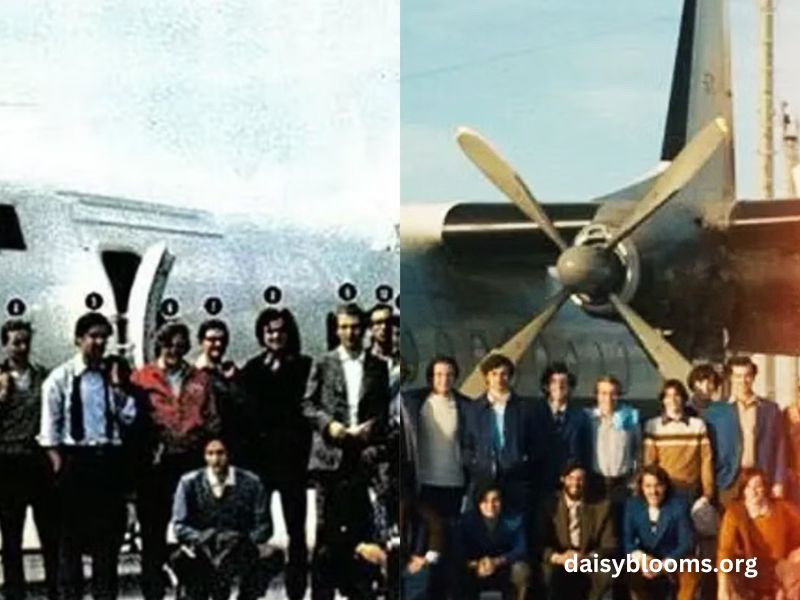“Society of the Snow” is a gripping survival drama that recounts the harrowing true story of the 1972 Andes plane crash. Directed by J.A. Bayona, the film has garnered acclaim for its authenticity and emotional depth. A standout feature of the movie is its meticulous recreation of real-life photographs, which serve as a poignant tribute to the survivors and the deceased.
The True Story Behind ‘Society of the Snow’
In October 1972, Uruguayan Air Force Flight 571, carrying 45 passengers—including members of the Old Christians Club rugby team—crashed into the Andes Mountains. The survivors endured 72 days in extreme conditions, resorting to cannibalism to stay alive. Their ordeal is one of the most remarkable survival stories in history.
The Filmmaking Approach
Director J.A. Bayona aimed for unparalleled realism in “Society of the Snow.” The film was shot in chronological order, with a cast of relatively unknown Argentine and Uruguayan actors. Notably, the production took place partly at the actual crash site in the Andes, enhancing the film’s authenticity.
Recreating Real-Life Photographs
A distinctive aspect of the film is its dedication to recreating real photographs from the 1972 crash. These images are seamlessly integrated into the narrative, often juxtaposed with the actors’ portrayals, blurring the lines between reality and fiction. This technique honors the memories of those who lived through the tragedy.
The Role of Survivors and Families
The involvement of survivors and the families of the deceased was instrumental in the film’s production. Several individuals made cameo appearances, and their insights were invaluable in ensuring the film’s accuracy and emotional resonance.
The Impact of ‘Society of the Snow’
Upon its release, “Society of the Snow” received widespread acclaim for its unflinching portrayal of human endurance and the will to survive. Critics and audiences alike praised its authenticity, with many highlighting the film’s respectful representation of the real-life events.
Comparing Real Photos with Film Scenes
The film’s dedication to authenticity is evident in its side-by-side comparisons of real photographs and their cinematic recreations. These comparisons underscore the filmmakers’ commitment to honoring the true story and provide viewers with a deeper understanding of the events.
The Legacy of the Andes Survivors
The survivors of the Andes crash have become symbols of resilience and hope. Their story continues to inspire countless individuals worldwide, serving as a testament to the strength of the human spirit in the face of unimaginable adversity.
The Significance of Accurate Depictions
Accurate portrayals of historical events, especially those involving trauma and survival, are crucial. “Society of the Snow” sets a benchmark in this regard, demonstrating the power of cinema to educate and evoke empathy through truthful storytelling.
The Role of Cinematography
The film’s cinematography plays a pivotal role in immersing viewers in the harsh realities of the Andes. The use of natural lighting, authentic locations, and close-up shots enhances the visceral experience, making the audience feel the cold, isolation, and desperation of the survivors.
The Emotional Journey
Beyond the physical challenges, the film delves into the psychological and emotional struggles faced by the survivors. Themes of guilt, hope, and the human will to live are explored, offering a profound commentary on the human condition.
The Global Reception
“Society of the Snow” has resonated with audiences globally, sparking discussions about survival, morality, and the human spirit. Its universal themes and compelling narrative have made it a significant addition to the genre of survival dramas.
The Educational Value
The film serves as an educational tool, shedding light on a lesser-known chapter of history. It provides insights into the Andes crash, the subsequent rescue efforts, and the ethical dilemmas faced by the survivors, offering a comprehensive understanding of the events.
The Director’s Vision
J.A. Bayona’s vision for “Society of the Snow” was to create a film that was both respectful and realistic. His meticulous attention to detail and dedication to authenticity have been instrumental in bringing this harrowing story to the screen.
The Cinematic Techniques
The film employs various cinematic techniques to convey the harshness of the environment and the intensity of the survivors’ experiences. From the use of sound to the portrayal of the vast, snow-covered landscapes, every element is crafted to immerse the viewer fully.
The Cultural Impact
“Society of the Snow” has sparked conversations about the ethics of survival and the human capacity for endurance. It has prompted viewers to reflect on their own values and the lengths they would go to in extreme circumstances.
The Future of Survival Dramas
The success of “Society of the Snow” may pave the way for more authentic and respectful portrayals of survival stories in cinema. It sets a precedent for filmmakers to approach such narratives with the seriousness and sensitivity they deserve.
The Survivor’s Perspective
For the survivors, seeing their story depicted on screen is both cathartic and challenging. “Society of the Snow” offers them a platform to share their experiences, ensuring that the lessons learned from their ordeal are not forgotten.
The Role of Music
The film’s score complements its intense narrative, using music to underscore the emotional and physical challenges faced by the survivors. The soundtrack enhances the viewing experience, adding depth to the.
Conclusion
“Society of the Snow” stands as a powerful testament to human resilience and the unyielding will to survive in the most extreme circumstances. Through its meticulous attention to detail, the film not only recreates a pivotal moment in history but also honors the survivors of the 1972 Andes crash. By blending real photographs with cinematic scenes, it offers an authentic portrayal of the harrowing journey that captivated the world. The film’s success lies in its ability to educate, inspire, and evoke deep emotional responses, making it an essential piece of storytelling that continues to resonate globally. As audiences reflect on the emotional and psychological toll of survival, “Society of the Snow” reinforces the strength of the human spirit against all odds.


